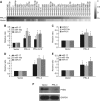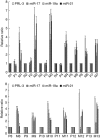miR-21, miR-17 and miR-19a induced by phosphatase of regenerating liver-3 promote the proliferation and metastasis of colon cancer
- PMID: 22677902
- PMCID: PMC3394980
- DOI: 10.1038/bjc.2012.251
miR-21, miR-17 and miR-19a induced by phosphatase of regenerating liver-3 promote the proliferation and metastasis of colon cancer
Retraction in
-
Retraction Note: miR-21, miR-17 and miR-19a induced by phosphatase of regenerating liver-3 promote the proliferation and metastasis of colon cancer.Br J Cancer. 2025 Sep;133(4):595. doi: 10.1038/s41416-025-03135-w. Br J Cancer. 2025. PMID: 40715587 Free PMC article. No abstract available.
Abstract
Background: Phosphatase of regenerating liver-3 (PRL-3) is an oncogene known to promote tumour metastasis, especially in colorectal cancer (CRC). Here, we demonstrate that the miR-21, miR-17 and miR-19a expressions induced by PRL-3 are involved in the proliferation and metastasis of colon cancer.
Methods: Microarray analysis and quantitative reverse-transcription polymerase chain reactions (qRT-PCR) were used to investigate the changes in miRNA expression due to the overexpression of PRL-3. Transwell chamber invasion assays, CCK-8 proliferation assays and RNA interference assays were used to explore the effects of PRL-3 on miR-21, miR-17 and miR-19a expression in colon cancer cells. Immunohistochemistry and qRT-PCR were performed in colon cancer tissues to evaluate the expression of PRL-3, signal transducer and activator of transcription 3 (STAT3), miR-21, miR-17 and miR-19a.
Results: Our study demonstrated that the overexpression of PRL-3 in colon cancer cells induced the expression of miR-21, miR-17 and miR-19a by activating STAT3. Subsequently, these microRNAs contributed to the increased proliferation and invasiveness of the colon cancer cells. Positive correlations between PRL-3 and these microRNAs were also observed in matched primary colon cancer tissues and metastatic lesions.
Conclusion: miR-21, miR-17 and miR-19a induced by PRL-3 contribute to the proliferation and invasion of colon cancer.
Figures






References
-
- Asangani IA, Rasheed SA, Nikolova DA, Leupold JH, Colburn NH, Post S, Allgayer H (2008) MicroRNA-21 (miR-21) post-transcriptionally downregulates tumor suppressor Pdcd4 and stimulates invasion, intravasation and metastasis in colorectal cancer. Oncogene 27: 2128–2136 - PubMed
-
- Barbieri I, Pensa S, Pannellini T, Quaglino E, Maritano D, Demaria M, Voster A, Turkson J, Cavallo F, Watson CJ, Provero P, Musiani P, Poli V (2010) Constitutively active Stat3 enhances neu-mediated migration and metastasis in mammary tumors via upregulation of Cten. Cancer Res 70: 2558–2567 - PubMed
-
- Bardelli A, Saha S, Sager JA, Romans KE, Xin B, Markowitz SD, Lengauer C, Velculescu VE, Kinzler KW, Vogelstein B (2003) PRL-3 expression in metastatic cancers. Clin Cancer Res 9: 5607–5615 - PubMed
-
- Brock M, Trenkmann M, Gay RE, Michel BA, Gay S, Fischler M, Ulrich S, Speich R, Huber LC (2009) Interleukin-6 modulates the expression of the bone morphogenic protein receptor type II through a novel STAT3-microRNA cluster 17/92 pathway. Circ Res 104: 1184–1191 - PubMed
Publication types
MeSH terms
Substances
LinkOut - more resources
Full Text Sources
Medical
Molecular Biology Databases
Miscellaneous

